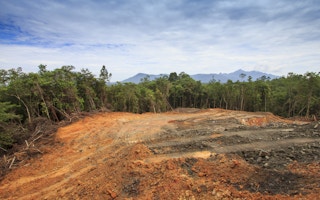Clear-cut rainforests and homeless orangutans make for powerful images, but it’s what you don’t see — hidden just below the surface — that may be the most sinister threat from tropical development. Long after the last tree is harvested from a peat swamp, decomposition of the soil continues to release carbon dioxide into the atmosphere. Now, alarming new models show us how much is at stake, and how quickly it is being lost.
Just over half of the world’s tropical peat is found in Southeast Asia, where swamps began forming 6-8,000 years ago. The organic material accumulates at a rate of 0.2-2.0 millimeters per year, locking in large quantities of carbon. There it safely remains — unless the land is drained for agriculture or development.
By 2010, oil palm plantations had replaced 2.1 million hectares (8,100 square miles) of the region’s peat forests, while another 2.3 million hectares had been logged and abandoned. Combined, that is just smaller than Denmark.
According to new models published by a team of researchers with the U.S. Forest Service and Universities of New Hampshire and Oregon State, that land will release 8.7 gigatons of carbon dioxide over the next 100 years.
To put this in perspective, that is equal to 23 power plants consuming 47 million train car-loads of coal during the same period. To offset this, we need to keep 18 million cars off the roadways for a century, or prevent every car on the planet from driving for two years.
“Any drainage causes peat subsidence from oxidation, consolidation and compaction…and increases vulnerability to fire,” the lead author, Matthew Warren, explained to Mongabay. “Emissions are pretty much independent of peat depth, so converting shallow (1-2m) peat still releases a whole lot of carbon.”
Exactly how much carbon the shallower peat releases has been one focus of Warren’s work, and these models are in part derived from peat sampling he and his colleagues conducted throughout Indonesia. There, they found that one hectare of peat commonly contains over 2,000 tons of carbon, while “exceptionally thick” peat (deeper than 12 meters) can store over 7,500 tons.
Armed with these numbers, the authors look at common land-use scenarios, and quantify the effects of drainage, fire, and restoration on peat loss under three different climate futures. These models improve upon previous studies by including more accurate rainfall predictions, and incorporating more fine-grained changes in drainage canal effectiveness and litter input over time. In addition, the frequency and effect of fire is bounded by both weather and fluctuating water tables.
From these models, the authors learned that the land use most detrimental to peat, regardless of climate, is the current standard practice: clearing, draining, and burning before each 25-year rotation of oil palm planting.
The only scenario more destructive is clearing followed by complete abandonment, which leaves an area susceptible to uncontrolled fires. This worst-case scenario can cause total peat loss, but only under the driest of the climate futures.
“
Any drainage causes peat subsidence from oxidation, consolidation and compaction. Emissions are pretty much independent of peat depth, so converting shallow (1-2m) peat still releases a whole lot of carbon.”
Matthew Warren, researcher, US Forest Service
Unsurprisingly, leaving the natural forest intact is the best way to preserve peat. But, if oil palm must be planted, then one crop rotation followed by optimum restoration — including complete blockage of drainage canals and aggressive fire prevention — results in the least peat loss.
However, the authors point out that even under this scenario, “carbon recovery for one 25-year oil palm rotation would take centuries under favorable climatic conditions, so the basic conclusion that it is a very slow process is justified.”
In short, agricultural activities that require draining peat will always result in near-term carbon loss. And, although the effect can be mitigated somewhat by aggressive fire prevention and increasing the water table, it cannot be avoided completely.
“Maintaining higher water levels, as suggested by [the Roundtable on Sustainable Palm Oil] and Indonesian environmental laws, slows the rate of carbon loss,” Warren said, “but does not prevent it.”
He points out that aboveground rainforest biomass stores as much carbon as just the top 35 centimeters of peat. Therefore, emissions from plantations on peat — even shallow peat — will far exceed emissions from those growing on mineral soil.
“Developing and expanding new agricultural commodities that do not require drainage, such as sago palm, or practicing true sustainable forestry is the only way to sustainably exploit peatlands and keep the carbon in the ground,” Warren said.
This story was published with permission from Mongabay.com










